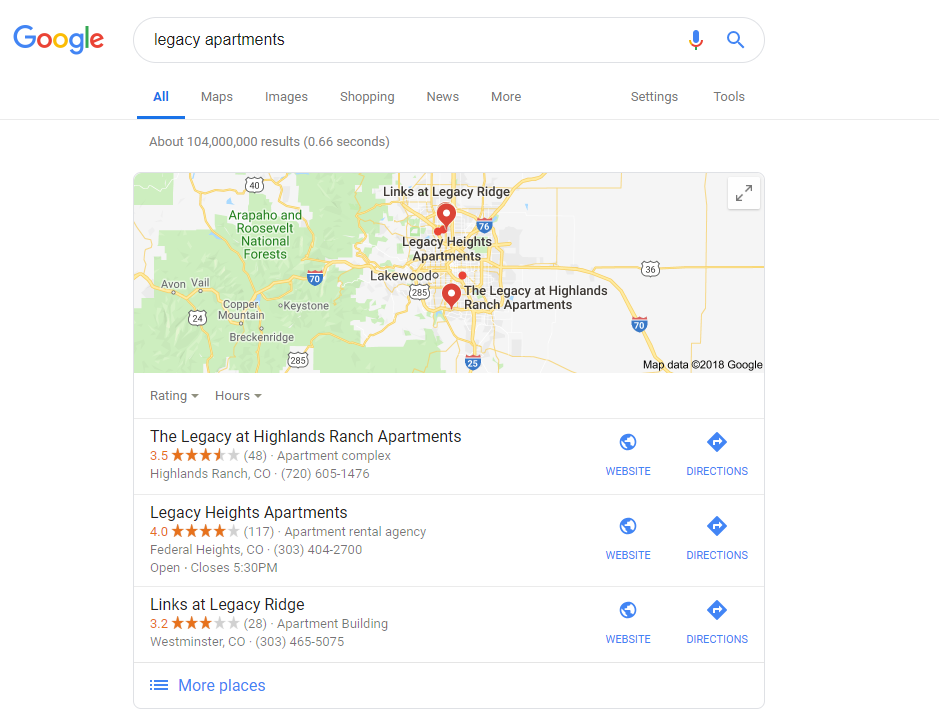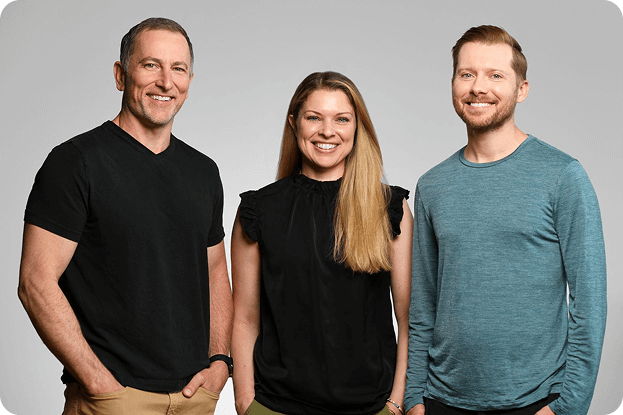Welcome to fourth round of Google Updates – with a lens on the Local Search Ranking Factors, released this month for 2018! Yearly, a myriad of SEO professionals come together to explore the local space and publish their yearly take on the changing landscape. This year, we will explore the two sections the study focused on: Local Pack/Finder Ranking Factors and the Localized Organic Ranking Factors. Let’s dig in with a lens on multifamily.
Local Pack/Finder Ranking Factors
The Local Pack has been around for a while now, taking up some large real estate in the SERPs. When a user searches for a business on Google (with some local intent), then the Local Pack pops up showing three results, alongside a map to show you where your interest point is located. Counterintuitive to other industries, multifamily doesn’t pull Local Pack results often, except in the case of a property with a common/popular name. The ILS’ commonly dominate non-branded searches in this industry like, “two bedroom apartment denver”.

For 2018, the Local Pack factors include the following, as listed on Moz’s website:
-
Google My Business Signals (Proximity, categories, keyword in business title, etc.) 25.12%
-
Link Signals (Inbound anchor text, linking domain authority, linking domain quantity, etc.) 16.53%
-
Review Signals (Review quantity, review velocity, review diversity, etc.) 15.44%
-
On-Page Signals (Presence of NAP, keywords in titles, domain authority, etc.) 13.82%
-
Citation Signals (IYP/aggregator NAP consistency, citation volume, etc.) 10.82%
-
Behavioral Signals (Click-through rate, mobile clicks to call, check-ins, etc.) 9.56%
-
Personalization 5.88%
-
Social Signals (Google engagement, Facebook engagement, Twitter engagement, etc.) 2.82%
Across the board, Google My Business has continually been increasing in importance. Your NAP: name, address, and phone number are ever-important to give you a chance to shine in your local market. Alongside GMB, reviews help boost your ranking in the Local Pack – think of it like a popularity contest for renters between you and your comps.
Interestingly, some technical on-site aspects are also in the mix for ranking factors like your click-through rate, mobile clicks to call, domain authority, metadata keyword focus, and a few others that show your engagement with your target audiences. Again, we’ve seen that apartments with popular names in local markets struggle to attract audiences due to heavy competition in the SERPs alongside other properties in the area. Imagine renters going online and finding four “Legacy Apartments” in the same city, properties like this struggle to get click-throughs and calls due to the a high volume of results showing similar-looking buildings nearby rather than your property front and center at the search.
We’d recommend three main tricks to boost your ranking in the Local Pack for your property:
-
Check your Google My Business listing – it’s common that apartment buildings verify their listing as they open and then completely forget about it. Have you renamed your building, changed addresses from the makeshift leasing office you were in during lease-up, or switched your website domain? Make sure all information is up-to-date and accurate!
-
Monitor your reviews and try to get new ones – we’ve written about this earlier this year. Check out our tips for managing, responding to, and getting new reviews for your property.
-
Keep a close eye on fluctuations with your technical site metrics like click-through, calls, and your position for non-branded keywords. Big fluctuations, especially negatively, can greatly impact your local ranking and make your apartment fall off the map for interested prospects.
Localized Organic Ranking Factors
Think of this section, as compared to the Local Pack, as the rest of the search results. Taking a deep dive into why your property can show over your competitors, Moz aggregated the following factors:
-
Link Signals (Inbound anchor text, linking domain authority, linking domain quantity, etc.) 27.94%
-
On-Page Signals (Presence of NAP, keywords in titles, domain authority, etc.) 26.03%
-
Behavioral Signals (Click-through rate, mobile clicks to call, check-ins, etc.) 11.5%
-
Google My Business Signals (Proximity, categories, keyword in business title, etc.) 8.85%
-
Citation Signals (IYP/aggregator NAP consistency, citation volume, etc.) 8.41%
-
Personalization 7.32%
-
Review Signals (Review quantity, review velocity, review diversity, etc.) 6.47%
-
Social Signals (Google engagement, Facebook engagement, Twitter engagement, etc.) 3.47%
Split down the middle between some on-site and some off-site factors, the list is a comprehensive look at how you can attract renters using multiple touchpoints online. We wrote about this a few months back, but it’s as important as ever to focus on both to find users wherever they are online looking for a new place to live.

On-site, the factors include your local information being clearly listed (on your contact page, for example), a keyword focus for your metadata, and again, your CTR, calls, etc. Here, as above, we want to stress how important it is to have your business information correct on-site, and to focus on a good user experience to ensure renters come on your site and stay to learn more.
The top factor listed above, with on-site factors following closely behind, is your link signals – the biggest question that SEO’s continue to get. The multifamily industry has always struggled to get good, high-quality inbound links to their sites – aside from a few with impeccable design or a few with an active fanbase in the community. A shortlist of fun and creative ideas could include:
-
Hosting a food drive and partnering with the local news and a nearby homeless shelter
-
Adding a new amenity that will grab the attention of certain communities online – techies, foodies, or eco-conscious young professionals
-
Partnering with a neighboring bar or restaurant for an event or a signature dish/drink for the community
Lastly, off-site factors like your social engagement, citations, reviews, and Google My Business, continue to work hand-in-hand with what you’re promoting on-site to show Google you are a reputable community. Make sure to keep track of your off-site channels mentioned above and get creative! Google Posts are a favorite of ours to showcase your property off-site, or you can focus on a campaign on your social channels to boost engagement – like a contest on social showcasing the best designed apartments at your property. Continually having high engagement will do wonders for your online presence, for both Google and new renters!
What are your thoughts on the 2018 Local Search Ranking Factors? Any surprises, or were these already tricks up your sleeve? Reach out to nerd out with us on some more local talk!








